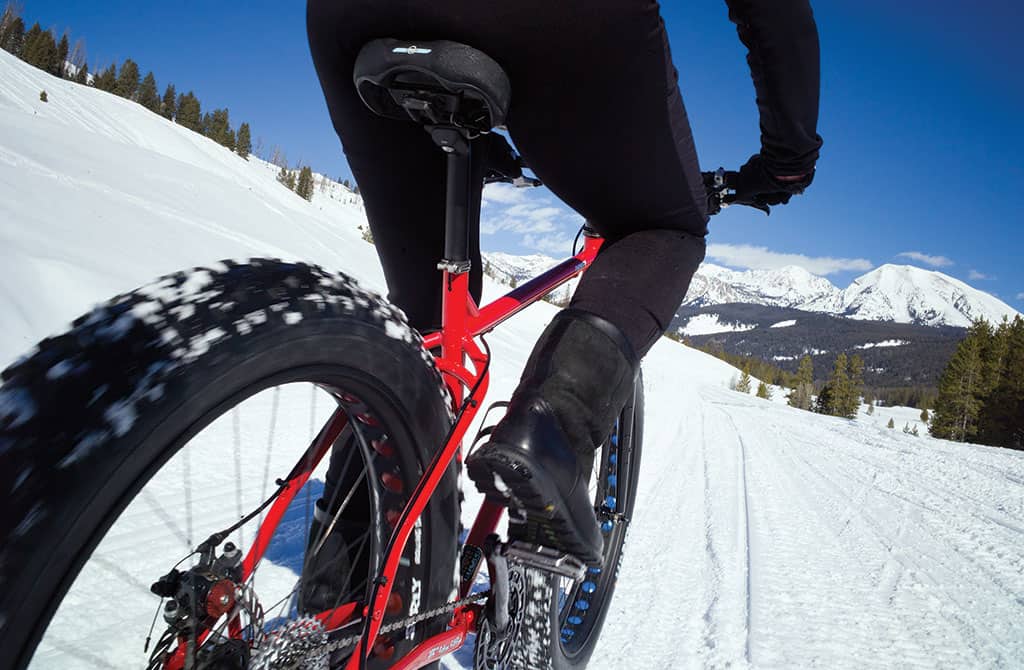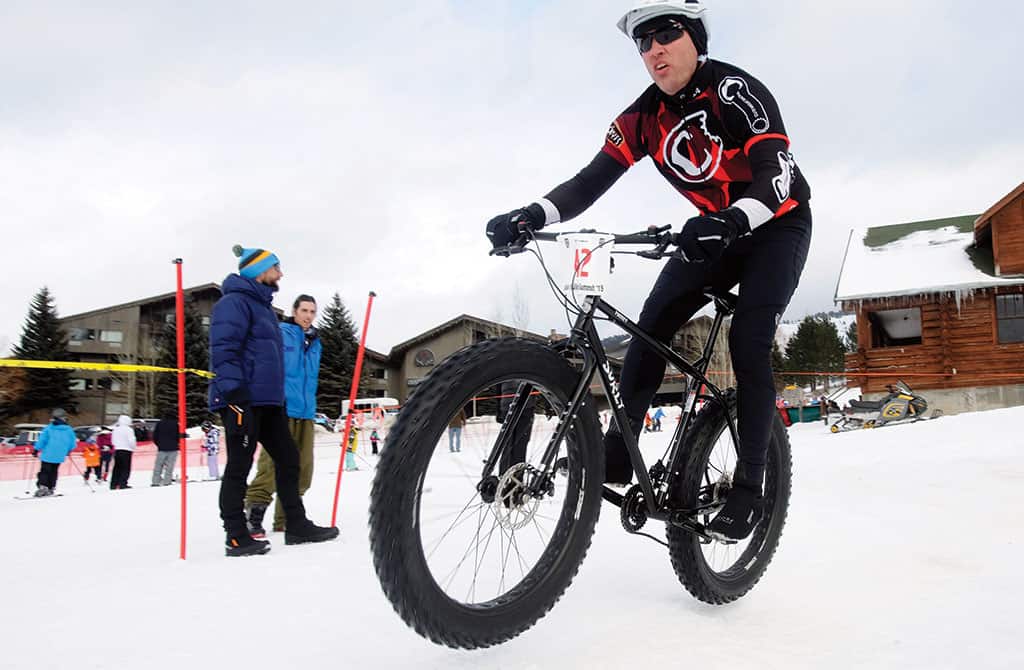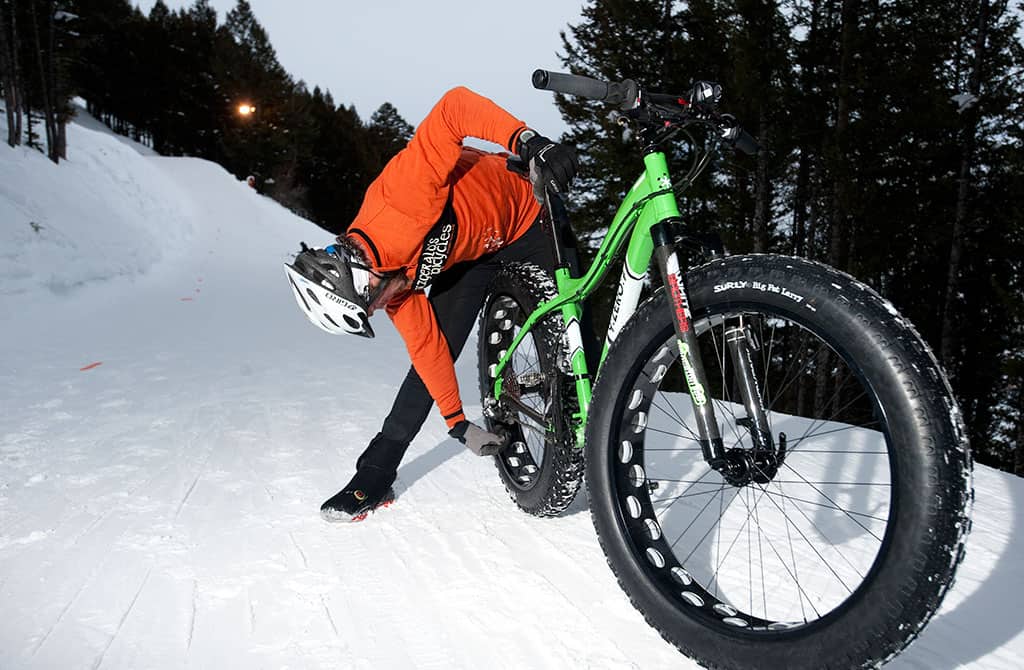Read The
Current Issue
Rolling Over
Put clownishly large wheels and tires on a bike and you can ride on snow.
By JULIE KlING

FAT BIKES AREN’T a fad anymore. Originally designed to float on top of groomed or packed snow, fat bikes were originally called snow bikes. You went snow biking.
Since the earliest models of these bikes—they have frames similar to those of mountain bikes, but wider forks to accommodate wheels and tires that are nearly four inches wide—debuted around 2000, enterprising cyclists have found enough other uses for them that they’re now called, more generically, fat bikes. Riders use them on sand. They’re also a good option for some types of mountain biking trails. Arnold Schwarzenegger was even photographed riding one around a Beverly Hills neighborhood.
“Now that there are carbon frame and dual and full-suspension fat bikes, there are lots of people buying them and getting new wheelsets,” says Kyle Wies, sales manager at Fitzgerald’s Bicycles, located at the base of the west side of Teton Pass in Victor, Idaho. “This year, sales have taken off year-round.” With one hundred manufacturers now on the scene, fat bike sales are the fastest-growing segment of the $6.2 billion bike industry, accounting for $40 million of business last year. Kmart and Walmart even sell them.
While fat bikes are no longer limited to snow, that is where they shine and why most riders, at least riders around here, buy them. “When the skiing is not great, it is a fun way to get out for a couple of hours,” says Todd Johnson, an avid cyclist and ski instructor. “Whether you are in town or towing your kids around, it’s a great feeling to be on a bike when it’s cold out. The groomed trails on Cache Creek make it really easy to train.” While there are many places that welcome them, there are two destinations you will not—at least not yet—see a fat bike: Grand Teton and Yellowstone national parks.

WADE VAGIAS, THE former management assistant to Yellowstone’s superintendent, says one of the safety concerns Yellowstone has about fat bikes is the ease of travel on the hard-packed groomed trails in the morning and the potential to get stuck when the snow softens. Riders could easily cruise ten miles down a road covered in packed snow in the morning when temperatures are cool and the snow is frozen hard. But if temperatures rise in the afternoon and the packed snow softens, it takes much more energy and time to return. Additional concerns about wildlife and sharing trails with snowcoaches, snowmobiles, and skiers have led the park to deny the one or two requests Vagias says it gets a year. “When we look at conflicts with fat bikes and start to overlay the safety concerns, it hasn’t penciled out,” says Vagias, who is now superintendent of Craters of the Moon National Monument and Preserve in Idaho. “It is a new and emerging use, and there are ample opportunities for snow biking in the area.”
Yellowstone last considered fat bikes three years ago and just closed another long-term monitoring plan where it received more comments requesting access, Vagias says. But it has no plans to revise its restrictions. Grand Teton National Park spokesman Andrew White says they look at the use each spring, but it would take an analysis of the 1969 National Environmental Policy Act to change the rules, which are determined on a park-by-park basis. “It is definitely on our radar,” White says. “If we see this use continuing to increase, that is something we would look into.”
For now, fat bikes are considered wheeled vehicles and are allowed only on the roads open to cars in the winter. You can ride a fat bike on the Inner Park Loop Road until the Bradley/Taggart lakes trailhead but not on the groomed snow beyond that. That is the same point at which cars must stop in the winter. Riding fat bikes is also restricted in some national forests and many privately groomed snow tracks.
David Hunger has run Teton Mountain Bike Tours on the main roads in Grand Teton National Park for twenty-five years and is confident that the industry growth will change the current policies in the park and open up more access in the national forest as well. “I think the national parks will open up down the road. They see fat biking is not going away. It has grown so fast,” Hunger says. “Someone said four years ago we are riding a wave. I didn’t understand what they were saying, [but] I do now. And I think we have two more years to go before it crests.”
“We have been trying to open up a dialogue with the national parks so we can ride,” says Scott Fitzgerald, the founder of Fitzgerald’s Bicycles and its owner until June. “The regulations for wheeled vehicles were written before fat bikes existed. But the agencies don’t have the bandwidth to open up a dialogue.” Fitzgerald even started a pilot program where he offered fat bikes to park rangers in the national parks. “Everyone who gets on one realizes pretty quickly there is no conflict,” he says.
But the fat bike lobby has been met with nothing but “classic government red tape,” Fitzgerald says. “The park had no mechanism to accept the bikes, because there are no fat bikes allowed on snow.”

WHILE HUNGER IS clearly partial to Jackson Hole trails, he concedes the local fat bike lobby has made more inroads in Teton Valley, Idaho. Grand Targhee Ski Resort began grooming singletrack trails last winter (it opened its Nordic trails, conditions permitting, to fat bikes several years ago), and this winter, Teton Valley Trails and Pathways (TVTAP) allows fat bikes on the five winter tracks it grooms for Nordic skiers.
In an attempt to help TVTAP keep an open mind to fat bikes, Fitzgerald’s Bicycles sells around $500 of by-donation stickers a year. Fat bikers are not required to purchase them, but if they do, the proceeds of their donations go to TVTAP’s grooming fund.
Also, the Global Fat Bike Summit was conceived in Victor, Idaho. Four years ago, Fitzgerald—whose shop was the first in the area to begin selling fat bikes more than a decade ago—reached out to his largest distributor, Gary Sjoquist of Quality Bicycle Products, to start the summit. Now held annually in the wintertime, the summit seeks to raise awareness of fat biking and also to secure greater access to riding fat bikes on public lands. The summit has been held in West Yellowstone, Montana; Island Park, Idaho; Ogden, Utah; and, last year, at Snow King Mountain Resort in Jackson Hole. Attendance set a record: 152 riders, fat biking advocates, and private and public land managers, including a representative from Grand Teton National Park, came.
Sjoquist, now a full-time fat bike advocate, this year hosts regional summits attached to large fat bike races in Crested Butte, Colorado; Ogden; and Marquette, Michigan. His goal is to increase fat bike access to public lands while educating local riders about etiquette for the snow conditions unique to each area.

WHILE RIDERS WAIT for entry into national parks, there are plenty of other places to go. Fat bikes can’t handle powder, but can do most any trail groomed for cross-country skiing or snowmobiling (assuming they are allowed). In addition to the twenty-eight miles of multiuse tracks, TVTAP estimates there are dozens more miles of trails, stretching from Victor to Rexburg. Some of these are packed in by the bikers themselves and go into the Big Hole Mountains and up Darby and Teton canyons in the Tetons. Warning if you’re planning on riding in the Big Holes: locals joke that if you’re not pushing your bike, you’re not riding in the Big Holes.
Trails on and around Togwotee Pass are groomed for snowmobiling, but fat biking is allowed, too. At the base of Togwotee Pass, Turpin Meadow Ranch (see page 124) allows fat bikes on its ten miles of groomed trails. If you’re willing to share the trail with dog sleds and snowmobiles, the ten-mile road to Granite Hot Springs in the Gros Ventre Mountains has a steaming, 103-degree reward at its end. East of downtown Jackson, Cache Creek is popular with every user group imaginable, from friends taking their dogs out for a leisurely after-work walk to skate and classic skiers, snowmobilers, and fat bikers. If the main road, groomed twice weekly by Teton County/Jackson Parks & Recreation, is too busy, look for the summer singletrack trails. The last two years, a group of fat biking friends has taken to tamping many of them down with snowshoes so they can ride them. “What we can really showcase here is the variety of styles and categories of fat biking—from wide Nordic trails to steeps and snowmobile tracks that are not as manicured,” Fitzgerald says. “The cool thing about riding here is we have it all.”
Teton Mountain Bike Tours’ Top 5 nearby winter riding destinations:
1. Turpin Meadow Ranch
2. Brooks Lake Lodge
3. Slide Lake to Gros Ventre
4. Granite Hot Springs
5. Cache Creek
Fat Bike Right
Fat bikes aren’T meant for all snow conditions, especially since they often share Nordic and cross-country skiing trails, for which good, smooth terrain is paramount. If ridden in the wrong conditions, fat bikes can ruin the careful grooming maintained by local organizations. Fat biking guidelines created by Teton Valley Trails and Pathways (TVTAP) have been adopted by the International Mountain Bicycling Association, among other organizations. “Are you being considerate of other users, or are you putting a big groove in the trail?” asks TVTAP executive director Tim Adams.
Fat Biking Guidelines:
Tires should be 3.7” or bigger.
Bikes should yield the right-of-way at all intersections. Bikes have brakes, skis don’t.
Never ride in classic ski tracks.
Ride on the firmest part of the track and leave room for skiers.
Stay to right side of the trail around corners and look for oncoming skiers.
Allow time for track to set up after grooming and before riding.
Do Not Ride:
In soft conditions (if you leave a rut that is 1 inch deep, it’s too soft).
If your tires are less than 3.7”.
If your bike’s tire pressure is greater than 10psi.




